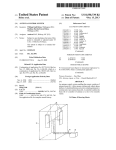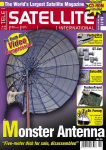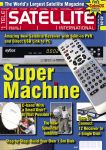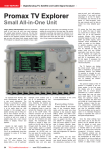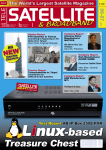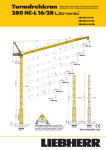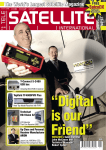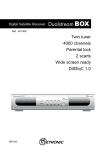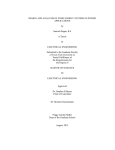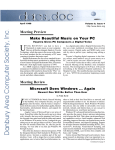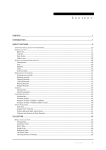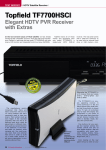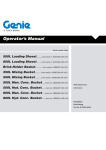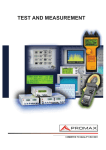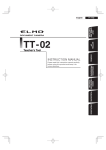Download Want More Satellites? - TELE
Transcript
The World’s Largest Satellite Magazine EE: EEK 99,- AU: AU$ 9.50 incl GST NG: Naira 400 LV: LVL 2,50 ZA: R 39-95 ID: Rp 35.000,- INTERNATIONAL 08-09 € 6,50 £ 4.95 SATELLITE 2006 26th Year Nº 194 TELE B 9318 E Want More Satellites? DIY Project: A Combined C/Ku-Band Feed Just Open a Can of Vegetables! Technisat Digit 4S Promax Explorer T90 Antenna Measures Everything in Digital Satellite TV and Radio One Dish and Many Satellites Small FTA receiver That Can Do It All Matrix Java A Slim Blind-Scan FTA Receiver Exclusive Test Reports ENG CD CONTENT TECHNISAT DIGIT 4S Digital FTA satellite receiver .........14 MATRIX JAVA Blind Scan FTA receiver ..............18 PROMAX TV Explorer Professional Digital/Analog TV, Satellite, Cable Signal Analyzer ................20 WAVE FRONTIER TOROIDAL T90 Multifeed dish ........24 DG-120 PLUS H-H mount motor ...28 “MINI ACTUATOR” from EDON DiSEqC motor ...................................36 Satellite Reception: Feed Made From a Vegetable Can .....30 Dear Readers Yes, those were the days…in the analog age you could either receive something, or you couldn’t. And when there was something to receive, then it was only one TV signal, or it was nothing. Either yes or no, black or white, 1 or 0. That was the analog age. In today’s digital age it is much more than just 1 and 0: there is an incredible variety. One TV signal is not necessarily the same as another; digital technology provides us with quite a few variants. As equipment users we may not notice this all that much, but as viewers it becomes much more evident, especially when the picture quality is something we may not have seen before. In this issue of TELE-satellite, we will focus on picture resolution in the DVB-S standard. Instead of one defined norm like there was in the analog days, DVB-S offers a variety like that found in a supermarket. But as equipment users we really don’t experience any of this. While most of the receivers on the market today can provide us the PIDs of a signal, there are (up until now) none that can display the picture resolution. Picture resolution is what we as viewers actually see on the TV screen; the PIDs just make reception possible. Once the PIDs are entered, reception functions properly. But the picture that we would be looking at for years is not explained in any way. What the receiver does to present the picture to you is available in detail but what we see is kept a secret. Programming providers are taking clear advantage of this. To save on transponder costs or to transmit more channels for the same amount of money, the picture resolution is simply reduced. The normal viewer has no idea that the providers can manipulate picture resolution. There is no hint of this given anywhere. The normal viewer just takes it as it comes and doesn’t realize that it could be different. In our report on page 46 of this issue we highlight the different variants. It is actually quite amazing: all satellite receivers can easily decode many of the different picture resolution variations. And in these same receivers there is no need to change a setting for this to work; they all produce a single video signal from these variants that every TV can correctly display. It doesn’t matter if the pixels are doubled, or even quadrupled, everything is handled automatically. Yes, the developers of these DVB norms know all the tricks on hiding the important data. Picture resolution is certainly the most important when it comes to a TV signal. Recently, the SatcoDX channel lists have started including the picture resolution of a satellite channel. And as time goes by, more and more SatcoDX scanning stations will switch over so that eventually anyone who wants to know it will be able to find out what the picture resolution is of every channel. This now gives you a new sorting capability: you can now search for programs that transmit in higher quality. You might then also be able to see that higher picture quality may go hand-in-hand with higher programming quality. Enjoy your high-quality TV! Alexander Wiese P.S. My favorite radio station of the month is Love Radio (SIRIUS 5E, 11.766H, 27500, 6163), Ukrainian soft hit parade with a few news breaks and hardly any commercials. Satellite Reception: C-Band Reception in Europe with a 120cm Antenna .............................. 42 Basic Functions: Basic manual for satellite receivers ....................... 10 Feature: The stronger, the better – it that always true? .......................................... 12 TELE-satellite Receiver Guide .......................32, 34 Satellite Technology: Video Quality in digital TV ..................................... 46 Satellites over India ............................................. 48 Satellite Exhibition/EEBC 2006: Telecom & Broadcasting will build „City of the Future“ ............................................. 49 ADVERTISERS ARION ................................................... 7 ARIZA ...................................................26 CHANGHONG .........................................15 DIGITAL TELEMEDIA ............................. 17 DOEBIS ............................................... 8,9 DVB SHOP ............................................. 41 EDON .................................................... 11 EMP .......................................................38 FORTECSTAR .........................................39 HORIZON ..............................................33 JAEGER/WEISS .....................................21 KATHREIN .............................................49 MOTECK ................................................31 OPENTECH.............................................52 PANSAT .................................................37 PANSAT .................................................43 PROMAX ................................................45 SADOUN ................................................35 SMARTWI ..............................................29 SPACECOM ............................................23 SPAUN ...................................................47 STAB .....................................................51 STARSAT ............................................... 4 STATE MICRO TECHNOLOGY .................. 19 TECHNISAT ........................................... 5 TELE-satellite CITY ...............................40 TOPFIELD .............................................. 2 VANTAGE ...............................................19 VANTAGE ...............................................31 BEGINNER SECTION Basic functions Basic manual for satellite receivers Heinz Koppitz It happens very often that you buy a cheap receiver without a manual or that you simply loose the one that was attached and now you don‘t know how to operate your receiver. The dozens of emails we receive every day in our office speak a clear language and many users have problems to find out how to look for new programs, sort or delete them without the manual. This article will try to help you finding and using the basic functions of your receiver. After that, you should be able to even use the more specific feature, by simple try and error. Satellite receivers are designed for television signal reception, which means that they have to be connected to a TV set, which they can use as OSD (on screen display). As a matter of fact, the front sides are mainly very poorly equipped and just contain a few buttons and a segment display, only very few receivers can show channel names and other information via an alphanumeric display, sometimes a display is missing at all. So if you are a radio freak, you‘ll have to turn on your TV for most receivers to know which channel you are currently listening to. The front sides are mainly very poorly equipped Some receivers offer a few buttons to operate the unit without remote control, but these buttons are just duplicates of the ones available on the remote, with one exception: Some of them contain a manual power on/off button, which sometimes can also be found on the back side. The other buttons are normally just channel up/down and maybe sometimes volume up/down. If a special button to enter the main menu is available, it‘s in most cases not very useful, because there are no numeric keys available on the receiver’s front and so you can‘t use most of the menu entries at all. - Your PC can be connected via the 9 pin RS232 connector - Sometimes a manual power switch is also available. Connect your TV via the Scart output As soon as the receiver is connected via the IF input with your antenna and via the Scart output with your TV, you can turn it on and you should immediately see some pictures. If you use an older TV set which has no Scart or video input, you have to connect it via your receiver‘s RF output. In this case you have to setup the correct channel on your TV first (in Europe it‘s normally UHF channel 38). Sometimes it happens that the receiver’s modulator and the TV use different modulaton types and the TV has to be setup first. In this case you‘ll need another TV to setup the receiver correctly, before you can connect it with the other one. The Scart and video input should always offer a picture and if you are very lucky, your receiver was pre-programmed with a channel list and you can immediately start zapping. However, if there‘s just some strange message on the TV, don‘t panic, some receivers need a few seconds before they show the first channel. In general we recommend that you perform a complete new system setup, this helps you to setup the receiver correctly and get all the new available channels, but please be aware that you need your original remote control to use all the special features of your device. To open the main menu, try to find a button, labelled with Menu or Setup on your remote. Sometimes the main menu also pops up if you press the OK button. The installation procedure the same with all receivers, but the necessary menu entries are sometimes labelled in a different way. is 1. Search (adjust satellites, select/ enter transponders, channel search) 2. Edit (antenna, transponders, group/sor t/delete programs) 3. Basic settings (language, video output, time setup, PIN) 4. Information (status, factory reset, software upgrade, games) First of all you A simple type remote control All available connectors are on the back side Luckily there‘s one point, where all receivers are similar, they offer the available connectors (which are also standardized) on the back side. Normally, the receiver is even ready for use if there are just the signal input and the video output connected. - The antenna cable has to be connected to the signal input, which is normally labelled IF Input or LNB-IN. - Your TV gets connected via the Scart plug (in Europe) - For all other regions, you can use the video output via the yellow RCA plug (e.g. USA) - Some receivers also offer an RF output in the UHF range - The audio signal e.g. for radio output can be taken from the white and red RCA plug (Stereo) 10 TELE-satellite International — www.TELE-satellite.com Standard plugs for LNB and Audio Can be found with many receivers: RS-232 plug for programming via PC Common with European receivers: the two SCART plugs for connecting TV and VCR UHF connectors (left) became a rarity nowadays, instead the S/PDIF plug is more common basically should setup the OSD language to English. This helps you to find the correct buttons on the remote control, which are normally labelled in English. Furthermore you can prevent some confusion, because it happens very often that translated menu entries contain strange and misunderstanding text. Also the manuals contain sometimes lots of translation errors, which can make it quite difficult for the beginner to understand their meaning. After setting up the OSD language, some other basic settings like time setup or video output have to be adjusted. Some receivers prompt you to enter a pin code to access these menus, which is normally 0000 or 1234. In the next step, it‘s time for cleaning up. If you bought a used receiver, there might be hundreds of old channels, but even a new receiver might contain some over aged data. In this case it‘s very useful to perform a complete factory reset. The important factory reset is normally available in every receiver The factory reset can be found on nearly every receiver and normally it does only reset channel data and some user settings, the so very important transponder and satellite data will not be deleted, because the receiver would be useless without them. However, considering that the receiver was manufactured a few months or even a few years ago, these transponder data might not be very up to date and you will probably have to add new transponders, which can be found in the SatcoDX lists at www.satcodx.com . Enable the „FTA only“ option during channel search If you own a FTA only receiver which has no CI slots or card readers, it‘s very useful to reduce the channel search to free programs only. Normally this can be done in the search menu by selecting the option „FTA only“. This helps you to keep control of your channel list and if you scan a few different satellites, you might fill up the receivers channel memory with hundreds of unwanted and encrypted channels and loose space for other free to air programs, because most receivers channel memory is limited to 3000 TV and 1000 radio channels. Right now, the most important functions are setup and you can start fine-tuning your receiver. Update your receiver via PC and the Internet It‘s much more comfortable to setup the receivers channel list on the PC than on the unit itself. Just connect your receiver and the PC via a RS232 cable (cross over cable) and use a PC program like SetEdit or some other program offered by the manufacturer to do the job. Sometimes these programs are capable of directly importing new channel lists from e.g. SatcoDX. Nearly every manufacturer offers a homepage on the internet and normally they are really worth a click. If you can‘t find the one of your receiver’s manufacturer, try some internet search engines and encyclopaedias like Google or Wikipedia, but normally you‘ll find the correct site by entering the manufacturers name with .com or with the local country extension. Be careful when upgrading the receivers software Finally I have a very important warning for you: Manufacturers offer from time to time new software updates to fix newly discovered bugs or to enhance the receiver’s functionality. If you are lucky, your receiver can update its software automatically via satellite, but most of the older models don‘t offer that option. You have to visit the manufacturer’s website, download the software there and install it to your receiver via the RS232 connector and your PC. In this case, please read all the information provided by the manufacturer on the website and check if you are really using the exactly fitting software for your receiver. If you install the wrong software, your receiver might get destroyed. www.TELE-satellite.com — TELE-satellite International 11 FEATURE Intermodulación The stronger, the better – it that always true? intermodulation it becomes. Now, if among Probably all our readers are aware that in order to have a reliable satellite reception, we need to have strong enough signal at the receiver input. Generally, the stronger the signal, the better its quality. Always? the strong signals, there is a weak one, its quality is decreased by the noise generated by its stronger companions. What we can do? Optimally, we would like to attenuate the “strong bullies” and preserve the strength of the “weak guy”. Unfortunately, this is very difficult to do. What we can do very easily, is to attenuate all signals by a few decibels in The quality of signal is related to the so- have probably already guessed what I aiming hope that this will reduce the intermodula- called signal-to-noise ratio S/N. For digital at. This is about reducing the sensitivity of a tion but not make the weak signal too weak signals, we more often use the carrier-to- receiver. Ham radio receivers and transceiv- for reception. noise ratio C/N but its meaning is practically ers quite often have buttons to either switch the same. Every satellite signal except for off their front-end RF amplifier or switch Does it work that way in satellite recep- the useful data has some amount of noise. on the input signal attenuator. Sometimes, tion too? That’s what we wanted to test for We would like to have as much useful signal both functions are available. We are speak- you. We added a manually adjustable 20 dB and as little noise as possible. Probably you ing here about reducing the input amplifier attenuator at the receiver input. We aimed know that to improve the signal to noise sensitivity by 10-20 dB. the dish to Hotbird satellite which has a lot of strong transponders (when received in ratio you may: • increase the size of your dish • replace your current LNB with a better How that can be? When a number of Europe). After traveling among transpond- strong signals are present at the receiver ers, we found the weakest one. In our case, input, they interfere with one another and it was 12303 V, SR=27500, FEC ¾. The However, there is yet another trick that produce extra noise. This phenomenon is table and the chart present the readings of may sometimes be used. It is relatively easy called intermodulation. Some receivers are our receiver strength and quality indicators to try and we will not have to spend a fortune more immune to intermodulation, the others taken when we were turning the knob of the on that. are less immune. There are no electronic cir- attenuator. We used approximately ¾ of its cuits that are absolutely protected against full range, what means 0-15 dB. one of lower noise figure. Those of our respected readers who have this. Moreover, the more sensitive we make some experience with the amateur radio the receiver, the less protective against As you can see, the signal quality actually improved when we added some attenuation. Even at -15 dB, the signal was still better than when fed directly. This confirms that the satellite TV receivers are also not free of the intermodulation problem. However, we must emphasize here that it was the ONLY signal on Hotbird that behaved in this way. All others (which had initial quality reading >60%) were simply maintaining its initial quality reading and were getting worse for bigger attenuation setting. So, adding an attenuator at the receiver input is not a universal solution. However, if you are (or want to be) a DX-er, you should have an attenuator in your drawer. If you want to pick a weak signal surrounded by the strong ones and its quality is not good enough to produce a stable video, before climbing to the roof to re-align your dish, insert an adjustable attenuator before your receiver input (LNB-IN). Turn its knob and observe the quality reading - you may be surprised! 12 TELE-satellite International — www.TELE-satellite.com TEST REPORT Satellite Receiver Technisat Digit 4S Small Jack-of-all-trades It was always the main target of the German days ago, parcel service delivered the new Digit company Technisat, to provide their costumers 4S to our testcenter, and so we tried to verify, if with easy to use, but powerful receivers. A few this claim is really true. At the first look you notice immediately the receiver’s small these experiences, and the new nel list can be updated directly east, HOTBIRD 13° east and Digit 4S is no exception. via satellite and you‘ll never ASTRA2 28.2° east at the same again have to worry about not- time, as well as the DisiCon LNB size, it‘s just 205x130x35mm, which let it appear quite dainty, After turning on the receiver and so it will certainly find its for first time, a nicely designed place in every living room shelf. installation wizard active channels in your list any series (unicable solution). Fur- more. thermore, appears the corresponding LOF values for C-band and for and helps the user with small Basically, the receiver is now circular polarized LNBs are pre- Objectively the new Technisat and easy to understand steps ready for use, special options programmed and if you want to receiver does not offer as much through the entire setup pro- like the video output signal or connect your S-band antenna, connectors as some rival prod- cedure. First of all, it shows all special DiSEqC parameters can you can enter the correct LOF ucts might do, but considering available OSD languages, which be setup via the main menu, values manually. the small size, the manufac- are English, Italian, Spanish, which is splitted in 6 big cat- turer did his very best to offer Greek, German, French, Turk- egories. The Digit 4S supports as much connectors as possi- ish, Swedish, Portuguese, Per- CVBS, RBB and S-Video output receiver with channel memory, ble and all important ones are sian, Polish, Czech, Hungarian and it handles PAL and NTSC capable available. Because the Digit 4S and Dutch, so every user should signals. entries, which should suffice for is a FTA receiver, there are no find a suitable one. CI slots or card readers. The attached remote control is very handy, it‘s labelling is very clear The antenna configuration of equipped handling this 5000 an FTA receiver, even if it‘s conThe pre-programmed satel- nected to a motorized antenna. lite list is not very up to date When we started the auto- offers by default the in Europe and the buttons offer a comfort- very common ASTRA and HOT- able pressure point. In general, BIRD reception. If you want to workmanship of this receiver receive additional satellites, or if leaves a very good impression. you use special DiSEqC param- The attached user manual is eters, you can also set them available in many different lan- up directly during installation. guages, always fitting for the Finally, the receiver checks if country of delivery. Technisat there‘s a software update available via satellite, and he asks Everyday use the user to perform a channel and contains just 20 European matic channels scan, we felt a search, either for all available satellites, but the user can add little bit disappointed, because What is more annoying than programs or just the free to air 13 manual entries. The Digit 4S it‘s working very accurately but ones. supports DiseqC 1.0, 1.2 and 1.3 also very slow, and it took the (USALS). Pleasantly, it also sup- Digit 4S nearly 7 minutes to scan the ASTRA1 satellites and a new device whose handling is so very complicated that you despair, and what‘s less funny If you prefer, you can also use ports the Technisat Multytenne, than installing a new satellite the ISIPRO system, which offers which we already introduced in a channel scan on a 80 trans- receiver and having to read a a predefined channel list with an earlier issue of TELE-satel- ponder satellite took nearly 8.5 huge manual? For years, Tech- over 370 entries from ASTRA lite magazine, and which ena- minutes, which is certainly no nisat is successfully trying to 19.2° east and HOTBIRD 13° bles you to receive ASTRA1 new speed record. Anyway, the prevent their costumers from east. The clue is that this chan- 19.2° channel scan feature is not so 14 TELE-satellite International — www.TELE-satellite.com east, ASTRA3A 23.5° very important, considering the also the channel change speed TECHNIC Manufacturer TechniSat Digital GmbH Julius-Saxler-Straße 3 TechniPark D-54550 Daun / Germany DATA fact that the ISIPRO system can between two programs on dif- be used, which offers an up to ferent transponders, which is far Homepage www.technisat.com date channel list without having below one second! After every Fax +352-710-707959 to scan for the programs first. channel change, the receiver Contact [email protected] For the advanced users, the shows an info bar, which is a Model Digit 4S receiver offers the possibility little bit oversized, but it con- Function Digital FTA satellite receiver to enter the correct PID values tains besides the EPG data a manually. lot of important information on Channel memory 5000 Satellites 33 current channel (Teletext, AC3 Another highlight of the sound, subtitles etc.). DIGIT 4S is the automatic EPG Symbol rates 1-45 Ms/sec. SCPC compatible yes (tested with 1,327 Ms/s) USALS yes DiSEqC 1.0 / 1.2 / 1.3 Scart connectors 2 scan. It allows the receiver to In comparison to other receiv- load all available EPG data from ers, the Technisat Digit 4S is selectable programs and store one of the few FTA receivers, them locally, so if you zap to whose EPG functions are really a channel and press the EPG working perfectly, while a lot of Audio connectors 2 x RCA button, the EPG data are avail- other receivers sometimes dis- UHF Modulator no able in the blink of an eye. appointed us with this feature. 0/12 Volt output no Digital audio output yes (optical and coaxial) EPG yes Also in every day use, the The tuner used by the Digit 4S receiver leaves a very good is very sensitive, and can handle impression. OK signals with a C/N between 4 C/Ku-Band compatible yes button opens the channel list, and 5 dB without any problems. Power supply which is very nicely designed Furthermore, SCPC signals with and shows you the current EPG very low symbol rates are no Pressing the data (if they are transmitted problem at all, our test trans- by content provider) for every ponder on the PAS12 45° east channel and a small preview with a symbol rate of 1320 Ks/s window. was handled successfully. Of course, you can 180-250 VAC, 50 Hz reduce the channel list to your favourite channels or you can sort it by content providers. 30 different timer entries and a built in Teletext decoder round up the perfect picture of A highlight of this receiver is Installation wizard Info bar Antenna setup Main menu EPG Channel search this new receiver. Expert conclusion + The Technisat Digit 4S is a very easy to use but powerful receiver and even for absolute beginners it‘s no big deal to use it. Because of his solid function and thoughtful features it‘s the ideal receiver for every day use in your living room. Considering its Thomas Haring TELE-satellit Test Center Österreich small size, the Digit 4S can also be used for camping trips or for your weekend house. - None 16 TELE-satellite International — www.TELE-satellite.com TEST REPORT Satellite Receiver Matrix Java A Slim Blind-Scan FTA Receiver The company PT Stella Satindo, based in Jakarta/ Indonesia, offers a wide range of satellite equipment under the brand name of Matrix. The Indonesian The receiver has a very elegant design, with silver casing and black front panel. It offers a signal indicator LED next to its channel display. A mains switch is located at left side of front panel, and six small buttons on the right allow for full operation control: channel up/ down, volume up/down, Menu and OK. The receiver comes included with RF and AV RCA cables. Only three different menu languages are available: English, Chinese, and Indonesian. The user manual that came with the test unit was written only in Indonesian language. It has many pictures and is quite useful for beginners, and explaining all the basics. Everyday Use Matrix Java comes preprogrammed with the TV/radio channels from 4 satellites, and is ready to be used with 4 LNBFs on a 1 dish system, as this is commonly used in Indonesia: controlled by a DiSEqC 1.0 switch the satellites are PalapaC2 (113.0E), Telkom1 (108.0E), Asiasat3S (105.5E) and Asiasat2 (100.5E). We were happy to note the fast channel switching speed. It only needs 1 second to wait before the selected channel appears on the TV screen. Pressing the Info button will show all the technical parameters for the selected channel: including PID‘s for video, + office of TELE-satellite had the opportunity to test one of their digital satellite receivers, a model called Matrix Java. Conclusion With the ability to blind-scan, this receiver could very quickly update the channel lists, without having to manually add any channels. This Matrix Java is a cost effective choice for beginners, and a very good choice as a slave receiver for feed hunting DXer‘s. audio, PCR, and teletext, if available. All typical LOF are supported, and less typical values can be entered manually, which allows for any signals in the Ku, C and Sbands. Universal LNBF, DiSEqC 1.2 and USALS are not supported. A test on a S-band satellite (Cakrawarta at 107.7E) could be handled with no problem by the Matrix Java, as well as a Kuband satellite (Measat1 at 91.5E). Despite that these two satellites contain encrypted pay-TV channels, and the Matrix Java is a FTA receiver only. Blind Scan Unfortunately, the Matrix Java has no transponders list, but this weakness is replaced by a blindscan feature. This blind scan process has two steps. First is to scan the active transponders, and then to scan the channels. In our test, the channel scan with blind-scan feature was quite fast. The values of the found symbol rates are somehow higher than expected (plus 7), accoridng to what is listed in SatcoDX Satellite Chart. We test the Matrix Java on PalapaC2 (113.0E), and found that it could not get all the active transponders, some weaker signals were passed. TECHNIC Manufacturer DATA PT Stella Satindo, Komplek Daan Mogot Prima, Blok B3 No. 7 Jl. Daan Mogot Raya km 12,8 Jakarta 11740, Indonesia Website www.stella.co.id Phone +62-21-54373829 Fax +62-21-54373833 Email [email protected] Model Matrix Java Function Blind Scan FTA receiver Channel Memory 1000 Satellites no Symbolrate 2 - 45 Mbps DiSEqC 1.0 22 kHz switch yes USALS no Programmable 0/12v no Scart connectors no V/Audio Output 3 X RCA Digital Audio Output no Color systems PAL, NTSC S-VHS Output yes RF Modulator yes (fixed VHF: 210 MHz) SCPC Compatible yes EPG no Teletext no Power Supply 80 - 270 VAC Power Consumption 20 W (max.) Expert conclusion Fast channel scan with blind scan feature. - No support for Universal Ku-Band LNBF, DiSEqC 1.2 and USALS. 18 TELE-satellite International — www.TELE-satellite.com Vincent Witjhun TELE-satellite Test Center Indonesia Main Menu in Indonesian Search Menu TEST REPORT Digital/Analog TV, Satellite and Cable Signal Analyzer Promax TV Explorer Small All-in-One Unit Large, Heavy and Expensive: these are words that most of you have up until now used whenever the subject signal analyzer comes up. The fact that it doesn’t always have to be this way was demonstrated by the Spanish company Promax. Not long ago we were told about their newest model Prodig 5 TV Explorer so naturally we wanted to have a test sample sent to us right away. The package we were waiting for arrived just a few days ago. We quickly unpacked everything and placed the 23x16x7.6 cm analyzer on the table. We were used to seeing analyzers that were twice the size and at a weight of only 1.9 kg, it was a true featherweight. easy-to-read and self-explanatory buttons. If you want to take advantage of all of the TV Explorer’s functions, you will have to do plenty of “learn-by-doing” since the user manual won’t be able to answer too many detailed questions. Of course the first step would be to select the type of signal you would like to measure. From there you go to the spectrum analyzer display. With analog terrestrial signals as well as with DVB-T and DVB-C signals, active channels would immediately be visible as peaks on the display. In satellite reception mode the correct switching voltage must first be selected as does the proper band and any DiSEqC parameters must also be chosen. The TV Explorer can supply 5V, 13V, 15V, 18V, 24V as well as 13V and 18V in combination with a 22 kHz signal. If necessary, the analyzer can switch to an external source of power. The TV Explorer can display the actual power usage of the LNB or multiswitch; an especially interesting feature. The DiSEqC 1.0 protocol is included for multifeed systems as DiSEqC 1.2 for motorized antennas. DiSEqC 1.1 and 1.3 (USALS) are unfortunately not supported. As expected from Promax, this unit’s workmanship left us with a very good impression. The chassis is surrounded by rubber to help protect it from damage while at the same time allowing it to be easily stood up. Also included in the package was a plastic carrying case to help protect it from moisture and dirt, a power supply, a charger cable for a vehicle as well as a variety of adapter plugs and a user manual written in English, French and Spanish. Despite its light weight, the built-in Li battery can power the Prodig-5 for up to 3.5 hours. This is an exceptionally long time compared to some of its larger brothers. The front panel sports a 5inch TFT color display, four status LED’s, a set of up/down/ left/right arrow buttons plus a set of 12 pushbuttons to control the analyzers various functions. Naturally, the buttons are designed so that moisture and dirt cannot get behind them. An adjustment knob is used for varying the frequency and is also used as the on/off switch. The antenna connector can be found on the top of the unit and can be used not only for satellite signals but also for terrestrial and cable signals. The manufacturer even thought to include a Scart connector on the left side of the box through which the output of the actual display signal is available and also external signals can be connected. An RS-232 port on the rear panel for sending measurement results to a PC and for uploading new software is also included. Unfortunately, the included user manual seemed somewhat lean and only gave 20 TELE-satellite International — www.TELE-satellite.com a brief description of the unit’s more important features. Everyday Use Promax wanted to take advantage of the increasing digitalization and thus paid very close attention to the receiver’s digital DVB-S, DVB-C and DVB-T compatibility. An analog terrestrial tuner is also included that happens to support the PAL, NTSC and SECAM TV standards. The OSD (on-screen display) is available in English, German, Spanish, French and Italian while an integrated light sensor automatically controls the displays contrast and brightness for optimum readability. After looking over the handbook for a short time, every user should become familiar with the elementary functions of the The spectrum display of the TV Explorer is available in two different modes. In the first mode the display acts at a reduced speed with an overall picture generated at a slower measurement speed that may not show every weak signal. In the Align Mode, the spectrum display is initially generated and then kept up to date at a much faster pace thereby making it ideal for precise adjustments. Additionally, in this mode the signal strength can also be presented audibly. The arrow buttons can be used to zoom in on individual frequency ranges or reposition the y-axis of the signal strength display. Once the initial settings have been taken care of, the first frequency can be selected that can later be looked at much more closely. Frequency selection is handled either by the control knob or by direct entry using the integrated 10-button keypad. The frequency entered can be either the downlink frequency or the transponder IF. With terrestrial signals it can be as simple as entering in the correct channel number. In digital mode a push of the Scan button is enough for the TV Explorer to attempt to find more information on the selected transponder/frequency. If it’s an analog signal, the unit will recognize this and indicate this by lighting the corresponding status LED. Since there is no integrated analog satellite tuner, picture and sound can only be displayed in terrestrial mode. In satellite mode, only measurement data is displayed. If it’s a digital transponder, the automatic scan function of the TV Explorer comes into play. In just a short time the symbolrate, FEC and other critical data of the transponder is identified. With a push of the TV button, the PMT’s are read, the channel list is displayed and the first receivable channel is presented. The TV Explorer uses an easy-to-read Info bar to display not only information such as PID’s and resolution but also the actual measured datarate, the service provider as well as any encryption used by the channel. This makes it easy to identify what satellite you happened to land on while adjusting the antenna. Otherwise it would also help to have a quick look at a frequency list such as can be found at www.satcodx.com. The TV Explorer supports the measurements of VBER, C/N, signal strength, MER and CBER to help with any fine tuning adjustments. The VBER measurement indicates the number of error bits after Viterbi error correction while the C/N (carrier-to-noise ratio) indicates the noise figure. MER is the modulation error rate and CBER is the number of error bits after error correction. All of this data can be displayed in an easy-to-read graphic while the other values are minimized and placed near the bottom of the display. To help make things even easier, the user can set up a number of different satellite profiles (several are already preprogrammed into the unit). This takes some of the guesswork out of setting up a multifeed system on multiple connectors since the TV Explorer by using the stored profiles will automatically adjust for the correct DiSEqC, polarization and band settings. In addition to this box being used as an analyzer, the TV Explorer would also make an interesting tool for the diehard feedhunter. Thanks to the spec- trum display, new signals can be found as soon as they appear and with the help of the Autoscan function can be recognized and identified. Aside from picture and audio, all of the signal’s critical data such as PID’s, FEC, symbolrate, resolution, datarate, TV standard, etc., are displayed on the screen. Unfortunately, the display of MPEG 4:2:2 signals is not possible. The handling of DVB-T and DVB-C signals as well as analog terrestrial signals is just as simple and professionally done. The capabilities of the small TV Explorer seem to be unlimited here as well. To properly test the TV Explorer we hooked it up to a USALS antenna and were very much amazed. Through its light weight and small size and also its handy carrying case, this unit (contrary to its larger cousins) is perfect for antenna alignment in hard to reach localities. Since the analyzer is not DiSEqC 1.3 compatible, we simply used an FTA receiver with integrated USALS and routed the video signal to the analyzer through the built-in Scart connector. With a push of a button we were able to switch back and forth between our measurement results and the FTA receiver. It doesn’t get any easier than this. We also have to give praise to the manufacturer’s competent and quick-to-respond technical support team. After posing a technical question anonymously, we are happy to say that we got the desired and, above all, correct answer within 24 hours. There’s no doubt: the TV Explorer will be the tool of choice in the TELE-satellite test center in the future. Measurement Results Snapshot of Hotbird (13° east) horizontal high band Signal display in DVB-S modes TECHNIC DATA Manufacturer Promax Electronica, S. A., Barcelona, Spain E-mail [email protected] Tel +34-93-260 20 02 Fax +34-93-338 11 26 Model Prodig-5 TV Explorer Function Professional Digital/Analog TV, Satellite, Cable Signal Analyzer Frequency Range Band 1: 45-865 MHz Measurement Range Terrestrial: 10-120 dBuV Band 2: 950-2150 MHz Satellite: 30-120 dBuV Accuracy Terrestrial: +/- 1.5 dB Satellite: +/- 2.5 dB Monitor 5” TFT Color Screen Color Systems PAL, NTSC, SECAM TV Standards M, N, B, G, I, D, K and L QPSK Symbolrates 2-45 Msps Power Supply Li-Ion 7.2V/11Ah 3.5 hours Operation without Recharge 3.0 hours Recharging Time Operating Temperature + Automatic recognition of symbolrate and FEC 5-40°C Expert conclusion The TV Explorer is an exceptionally handy, lightweight and compact analyzer that comes with everything you’d expect in a modern piece of test equipment. It has no trouble handling any kind of digital signal and can also deal with analog terresThomas Haring TELE-satellite trial signals as well. It is easy and logical to operate Test Center and should there ever be a problem, the manufacAustria turer’s first class technical support team is there to help. The TV Explorer would not only be a tool for the professional; it would also be an excellent addition to the test equipment rack of any satellite hobbyist. - The user manual only provides a general overview of the TV Explorer’s basic functions. The manufacturer should consider making some improvements here. 22 TELE-satellite International — www.TELE-satellite.com Measurement Antenna align Mode Mode (ms) Terrestrial 8 MHz 16 MHz 32 MHz 50 MHz 100 MHz 200 MHz 500 MHz Full 210 264 440 242 462 510 632 932 122 188 114 90 138 228 280 257 Satellite 16 MHz 32 MHz 50 MHz 100 MHz 200 MHz 500 MHz Full 144 348 348 416 600 610 714 144 144 348 228 224 352 470 Sampling rates of the TV Explorer spectrum analyzer TEST REPORT Satellite Dish The Toroidal Dish in North America One Dish and Many Satellites If you’ve been a regular reader of TELE-satellite magazine for the past years, then you should be familiar with the Wave Frontier T90 Toroidal satellite antenna and what it is all about. Much of the earlier discussions on the T90 had to do with instal- lations in Europe. Its capabilities were never really tested here in North America. After some research, we found that the T90 is readily available in this part of the world so we thought it might not be a bad idea to see what it can do here. the skew was properly adjusted. The LNBF holders themselves have several adjustments to help maximize the signal. After some fine position adjustments, we managed to get 60% signal quality. A Smart Scan (or Blind Scan) of this satellite revealed quite a few additional active transponders. Obviously, the T90 was correctly aligned to AMC5. Next we wanted to align to other satellites. And this is where the strength of this antenna should be shown. If the T90 was properly installed in the first place, thean we should be able to place additional LNBF’s on the rail and simply slide them along the rail into the proper position without any further alignment of the antenna. SBS6 is located 5° The T90 Antenna For those of you who are not familiar with the T90 we would like to take a moment and acquaint you with it. The WaveFrontier Toroidal T90 is a fixed Ku-band satellite antenna. What makes it different from other fixed dishes is that it is a multifeed antenna. A multifeed antenna is one that can be fitted with more than one LNB. Of course, you could modify a standard fixed antenna so that it can accept more than one LNB but only one of the LNBs would be in the antenna’s focal point. The others would be offset to one side or the other and would not receive as much signal as the central LNB. While this method might work, you usually could not have more than one LNB to either side of the central LNB because of excess signal loss. The reflector of a standard dish focuses the incoming satellite signal to a single point. The reflector of the Toroidal dish, on the other hand, focuses the signals to a focal line, and not to a single focal point. Any LNB placed in this focal line would be considered in focus with the satellite it was pointed to. And that’s the beauty of the T90 antenna: it comes with a rail on which can be mounted multiple LNBs. The rail is long enough to allow satellites within a 40° arc to be received. As long as the antenna is installed on a perfectly vertical mast and the skew is properly adjusted on the antenna mount, you simply need to align the dish to one satellite and all the other satellites you want to receive will easily fall into place. The rail is imprinted with gradients so that the LNBFs can easily be placed. For example, if the first satellite is at 91° west and the next satellite you want is at 97° west, align the dish to 91° west first and then simply slide the second LNBF along the rail to a point six degrees to the right of the first LNBF (when looking at the antenna from the front). The signal from the second satel- TELE-satellite editor Ron Roessel mounting LNBFs on the rail of a Wavefrontier Toroidal T90 multifeed dish at TELE-satellite's Test Center in the outskirts of New York lite should pop right in. The T90 in Action So obviously, the next question to be answered is, “what can you do with it here in North America?” Well, in order to answer this question we first needed to get our hands on a Toroidal T90 antenna. Once again, our friends at Sadoun Satellite Sales in Hilliard, Ohio came through for us. They provided us with the T90 dish as well as a set of four Sadoun KUL1 standard, single-output Ku-band LNBFs. They have a 0.4 dB noise figure, a 10.750 GHz local oscillator frequency and come in a slim design that makes them per- 24 TELE-satellite International — www.TELE-satellite.com fect for use with the T90. For a receiver we used a Pansat 6000 HXC with twin tuners. When setting up a Toroidal antenna, it is always a good idea to decide ahead of time what satellites you want to receive with it. In this way you can determine in advance which of those satellites would be your center satellite. For our tests we chose AMC3, AMC5, SBS6 and AMC9. We used AMC5 as the center satellite and installed the first LNBF on the center of the T90’s rail (0° point on the rail). The Pansat receiver was tuned to the New York Net mux on 12.182 GHz (H, SR 23000). We then aligned the T90 for maximum signal quality and at the same time made sure that to the east of AMC5 so it stands to reason that if a second LNBF were placed on the rail at a point 5° to the right of the first LNBF, we should be able to lock onto SBS6. So, we set up the Pansat box to a known active transponder on SBS6 (12.006 GHz, V, SR 6890), installed the second LNBF on the rail and watched the signal quality display as we slid the LNBF along the rail. Sure enough, the signal magically appeared as the LNBF reached the 5° mark on the rail! The position of the LNBF was adjusted for a maximum signal quality of 60%. Two more LNBF’s were installed and aligned to AMC3 and AMC9. In both cases it was just a matter of sliding the LNBF along the rail until it was at The LNBF holder can be moved left and right on the rail. It can be fixed by a little screw + Expert conclusion One dish, with very easy way to add several LNBFs - The frequently used 2° spacing in North America can only be achieved by manipulating the LNBF holders its designated position. Strong signals were observed on both of these satellites. Clearly the Wave Frontier T90 Toroidal antenna performs just as advertised. A single fixed dish was used to lock onto four satellites at the same time with exceptional signal quality from each of these satellites. The Pansat receiver easily jumped between these satellites via a DiSEqC 4X1 switch. However, this antenna is not limited to just four LNBF’s. The rail has plenty of room for more LNBF’s. So, if it’s more than four satellites that you want to receive, simply add more LNBF’s and position them correctly on the rail. One thing to keep in mind though: The width of the LNBF holders limits how close two satellites can be. As it turns out, the satellites must be 3° or more apart: the LNBF holders cannot be placed any closer than 3° apart. Unfortunately, many of the Kuband satellites above the North American sky are spaced only 2° apart. The design of the LNBF holder will not let you receive two adjacent satellites. It is possible to modify the holder so that they Closeup of the rail can be placed closer together on the rail but this would only work if the LNBFs themselves did not have a wide diameter feedhorn. The width of the feedhorn on the Sadoun KUL LNBFs that we used would prevent us from achieving 2° LNBF separation. Currently, it would seem that the Toroidal T90 antenna has a market with the DishNetwork and DirecTV PayTV services. This is supported by the fact that there are LNBs especially designed for use with the T90 antenna (LOF=11.250 GHZ, circular polarization) that can receive these services. The standard DTH LNBFs that come with the minidish come in a differently shaped housing that will not allow it to be installed on the T90 rail. The T90 will allow you receive a group of these PayTV satellites with just a single antenna while its larger size will give you extra protection against bad weather signal fade. But the purpose of this test was to see how well it would stack up against standard Ku-band satellites and we clearly showed that this versatile antenna can be used for much more than just PayTV signals. Echostar 1,2* IA7/Echostar 5* Horizons 1 Galaxy 10R Echostar 9* AMC 16/Echostar 7*/DirecTV 7S* SatMex 5 Anik F2 DirecTV 5*/Echostar8*/Echostar 10* Anik F1R AMC 15 AMC 1 AMC 4/DirecTV 1R,4S,8* Galaxy 4R 148.0° west 129.0° west 127.0° west 123.0° west 121.0° west 119.0° west 116.8° west 111.1° west 110.0° west 107.3° west 105.0° west 103.0° west 101.0° west 99.0° west IA5 Galaxy 3C IA6 Galaxy 11/Nimiq 1* IA8 AMC 3 AMC 2 AMC 9 Nimiq 2* AMC 5 SBS 6 DirecTV 1* AMC 6/Nahuel 1 Echostar 3* Amazonas Pas 9 Pas 3R Hispasat NSS 7 Telstar 12 Ron Roessel TELE-satellite Test Center North America 97.0° west 95.0° west 93.0° west 91.0° west 89.0° west 87.0° west 85.0° west 83.0° west 82.0° west 79.0° west 74.0° west 72.5° west 72.0° west 61.5° west 61.0° west 58.0° west 43.0° west 30.0° west 22.0° west 15.0° west MSNBC Feed on SBS6 List of Ku-band satellites that should be receivable in most parts of North America with the T90. The T90 can cover any group of satellites within a 40 deg orbital arc. Note: satellites marked with a * are DTH satellites. New York Net on AMC5 NBC News Color Bars on AMC9 TECHNIC DATA Model T90 Dimensions Main Reflector: 96.7cm (38.1”) W x 108.6cm (42.8”) H Net Weight 14.1 Kg (31.0 LBS) Sub Reflector: 36.1cm (14.2”) W x 83.6cm (32.9”) H Operating Frequency 10.7 – 12.75 GHz Polarization linear and circular Reception Range 40° in orbital arc Recommended Satellite Spacing 3 deg Gain 39.65 dB +/- 0.45 dB at 12.5 GHz Mount Type Elevation over azimuth Wind Loading 80 km/h (50 mph) operational and 200 km/h (125 mph) survival Acceptable Pole Diameter 60mm LNBF TECHNICAL DATA Model KUL1 Input Frequency 11.7 – 12.2 GHz Output Frequency 950 – 1450 MHz LOF 10.750 GHz LOF Stability +/- 1 MHz Noise Figure 0.4 dB Conversion Gain 57 dB Cross Polarization Isolation 22 dB Feedhorn Diameter 40mm www.TELE-satellite.com — TELE-satellite International 25 TEST REPORT H-H Mount DG-120 Plus – Made by Jaeger A sturdy H-H mount It doesn’t happen every day that we receive a product for testing and are absolutely delighted by it. This H-H mount motor drive is one of these nota- ble exceptions. It comes very close to its promise of ‘horizon to horizon’ and almost covers the complete orbital arc from 80° East to 80° West. responds to the local degree of latitude. This angle has already been considered when assembling the motor. The elevation, on the other hand, is displaced by this angle to an extent which leads for the complete construction to be out of its adjustment range. In order to adjust this displacement the rotating arm of H-H mounts is always bent by 30 or 40 degrees, depending on the manufacturer. The DG-120 Plus comes with a 40 degree offset bent, which is perfect for use in Central Europe as it allows convenient elevation angles of 32 to 34 degrees on the antenna’s scaling. The individual components of Jaeger’s DG-120 Plus motor Easy to assemble As soon as you open the packaging you feel like you’re holding a construction in hand which has a smart design and is well thought through. Only a few individual components that cannot easily be mixed up need to be assembled. Five minutes is all you should need for that. Before beginning with the assembly you have to make sure to define the local latitude on the latitude scale (not to be confused with the elevation scale on the opposite side). Next, the satellite antenna has to be mounted on the rotating arm. Unfortunately, there are no markings for exactly adjusting the antenna mounting support to the zero point of the motor casing. The crank on the lower side of the rotating arm, however, is very handy as it provides a fixed blocker for the antenna. The final step towards comple- tion is fixing the motor with the antenna to the pole – luckily this can be achieved in a very simple and quick way. We particular appreciated the fact that the unit can be mounted on the pole at any desired height. The profile of the dual pole clip works like a crampon, which means that the height and the angle of rotation can be slightly adjusted without risking for the whole unit to slide downwards. Antenna alignment With a polar mount system there are more aspects to consider than for a fixed antenna. However, the basic steps are similar even though we have to take into account the tilted pivot. The pivot of a polar mount is aligned in parallel to the axis of the Earth and consequently is tilted by an angle which cor- An H-H motor like this one can only work properly if the degree of latitude of the specific location is correct. 28 TELE-satellite International — www.TELE-satellite.com Everybody is still waiting for a quick fix for aligning the antenna to its zero position and there is no two-dimensional water level to check the upright position of the antenna pole. Pointing towards the South can still only be achieved using a compass or a GPS system and moving the antenna pole. Adjusting the system in line with the correct elevation can be similarly troublesome. But then again, this deficiency can hardly be blamed on the motor drive, as the adjustment is made on the antenna mount support and the accuracy of its scales is frequently insufficient. In such a case even the alignment chart of the very concise user’s manual isn’t of much use, although it goes out of its way to show the alignment values for any latitude with three decimal places. The connection sockets of the Jaeger motor. Since the control pulses are sent to the motor through the antenna cable the motor has to be installed between the LNB cables. Next to the F sockets there are buttons for manually moving the antenna to the left or to the right. Motor operation From zero position any desired satellite can be addressed using the manual controls or the DiSEqC 1.2 control of the receiver. Left and right movement can be selected manually thanks to two buttons which are located next to the F-sockets and thus can be reached easily. The alignment scale can be viewed from above so that the current position can be determined quickly. The motor runs quietly and very fast. This speed results in a rather high power consumption, however, which – together with the power supply of the LNBs – might be too much for some receivers. It is particularly the switch-on peak supply of some 1 Ampere that is cause for concern, as in some case the short-circuit protection of the receiver shut down the system when trying to move the dish. It is exactly because of this high power consumption that Jaeger offers an optional ‘Interface Box’ which is installed between the receiver and the motor. It is a fully operational DiSEqC 1.2 transmitter and at the same time provides the power required by the motor. With this Interface Box all receivers – even those with only DiSEqC 1.0 – can be used in connection with a polar mount antenna. The angle of rotation is entered using a remote control and sent to the motor with a “Goto X” command. This way angle values can be also stored and retrieved through one of 60 position numbers, if required. Satellite search in everyday use A DiSEqC 1.2 receiver sends the angle values required for a satellite search as “Goto X” commands in most cases. These commands can be processed flawlessly by the DG-120 Plus. We experienced occasional system crashes of the motor logic control which are triggered by power failures or short-circuit shutdowns caused by the receiver. Fortunately the motor controls can be reset using the DiSEqC 1.2 reset command (“Goto Reference” or “Goto Zero”) generated by the receiver. There is no more need for a mechanical reset directly on the motor. TECHNIC DATA Manufacturer JAEGER Industrial Co.Ltd., Taiwan, ROC Internet www.jaeger.com.tw Distributor Satellitentechnik Weiß GmbH, 93437 Furth im Wald, Deutschland Fax +49-9973-8417-17 Internet www.iev-weiss.de E-mail [email protected] Model DG120 Description H-H mount motor Alignment range 80° East to 80° West Speed 0.3 sec (19V) and 0.5 sec (13 V) Motor noise quiet Mounting pole 38 to 65 mm diameter Mounting height variably on the pole Antenna offset 40° Rotating arm 56 mm diameter Power consumption 200 to 350 mA Switch-on peak >1000 mA Expert conclusion This is a sturdy and fast H-H mount motor drive which fulfils high demands in terms of its mechanical construction. Its DiSEqC 1.2 functions fully conform to all specifications. In order to make it suitable also for older receivers its power consumption should be reduced, in particular its very high switch-on peak. Heinz Koppitz TELE-satellite Test Center Germany www.TELE-satellite.com — TELE-satellite International 29 SATELLITE RECEPTION Praxis Tip C-Band and Ku-Band In Focus Feed Made From a Vegetable Can Ingo Salomon What good is a can of vegetables? Well, how about this: open it up with a can opener, spoon out the contents and have it for lunch, clean out the empty can and then use it to build a combination feed. Just get yourself a copper tube from a hardware store like the ones used in heating systems and off you go. The C/Ku-Band feed used in real life at a 1.80 m dish receving PAS4 on 72East There are many satellites that transmit signals in both C-band and Ku-band. If you already have a large antenna, it won’t take much to modify the existing system so that both frequency ranges can be received. It all starts with a vegetable can that is 65mm in diameter. Remove the lids on both sides. Drill a hole in the side of the can large enough so that a 20mm copper tube can slide into it. A 90° copper elbow is then attached to the copper tube on the inside of the can. The other end of the tube goes to the Ku-band LNB. Important: the copper tube cannot be longer than 80mm while its diameter can be as small as 17mm and is determined by the reception frequency. The higher the frequency, the smaller the diameter. Installing this piece of handiwork will take some feeling. The C-band LNB should first be aligned to a C/Ku-band satellite such as PAS4 at 72° east in South Africa. The vegetable can is then placed over the C-band feed and slowly turned until the C-band signal is at its strongest. Reception through the copper tube protruding out of the can will of course be somewhat diminished, but by rotating the can the smallest level of attenuation can be found. Next, attach the Ku-band LNB to the exposed end of the copper tube and rotate it until the best signal strength is achieved. Finally, simply attach a DiSEqC switch so that you only have one cable going to the receiver and there you have it, the number of channels you can receive has greatly increased without any large investment: a C-band LNB for 45 Euros (17K), a Ku-band LNB for 20 Euros (0.4 dB) and some accessories for 5 Euros much of which the doit-yourselfer will probably already have in his stash of spare parts. Note: Naturally this combination does tend to reduce the signal level in only one frequency range compared to an individual feed. But this loss seems to be limited to roughly 10%. 30 TELE-satellite International — www.TELE-satellite.com C-band Screenshot from Pas4… …and from the same satellite in the Ku-band A peek at the inside of what used to be a vegetable can. The clamp is later used to secure it to the Cband feed. This was a vegetable can! The Ku-band LNB is mounted to a copper tube that has a 90° elbow Completed C/Ku-band assembly C/Ku-band satellites transmit in these areas with a minimum of 42 dBW. In the center of these zones as many as 261 digital FTA channels can be received. In the outer regions this number drops back to 33 TV Radio Volt Hertz Ms/sec S-VHS V 0/12 e azin TSI M ag Emb CA edded CI S lots e Seria Inter l f ac n er M ec Polahanical rizer Hard (Buil Disk t-in) Posit io Volt Outp0/12 ut t RCA S-VH Outp S ut Scar Outpt u Aud Outpio/Video ut Digit Outpal Audio ut Pow Sup er ply Satc ComoDX patib le Loop Thro edugh IF Mo d Outpulator ut L NTS C/PA USA ComLS patib le tible DiSE qC SCP ComC pa olrat Sym b Cha Memnnel ory DVB Satellite Receivers e TELE-satellite Receiver Guide Issue GB ARION 9400 PV2R 8000 1.0, 1.1, 1.2, 1.3 yes PAL D/K, B/G, I yes, UHF yes no 90-240V 50/60Hz yes 1.0, 1.1, 1.2 yes NTSC/ PAL yes, UHF yes no 2-40 yes 1.0, 1.1, 1.2 yes NTSC/ PAL yes yes 2-40 yes 1.0, 1.1, 1.2 no PAL yes 1.2 yes yes 1.0, 1.2 no NTSC/ PAL 1.0, 1.1, 1.2, 1.3 yes PAL D/K, B/G, I 2-45 yes yes yes yes, 2 yes yes no no yes yes, yes, 2 RS-232 no #192 2006 100-240V yes 50/60Hz (optical) yes yes, 2 yes yes no no yes yes, RS-232 yes no #188 2005 no 80-300V yes yes no no yes no no no no no no #193 2006 yes no 90-270V no yes no no no no no no no no no #191 2006 yes, UHF yes no 90-260 VAC 50/60Hz yes yes yes, 2 no no no no no yes, yes, 2 RS-232 no #189 2005 no yes no 230V 50Hz yes yes yes, 2 yes yes no no no yes, RS-232 no #186 2005 yes yes yes 90-240V 50/60Hz (optical) yes yes yes, 2 no no no no yes yes, yes, 2 RS-232 yes #191 2006 ARION AF-9300PVR 8000 2-45 BEETEL SD98 5000 (S/PDIF) BEL 5518 2000 BOTECH CA 9000 FTA/CI 4900 2-45 yes CHESS Digital 4000 FTA 3000 2-45 yes no DGSTATION Relook 400S 10000 2-40 yes DIGITAL EVERYWHERE Fire DTV External PC Set Top Box unlimited 2-40 yes 1.0, 1.1, 1.2 NTSC/ PAL no yes no 12 VDC no no no no no no no yes, in PC no yes, 1 no #187 2005 yes NTSC/ PAL yes yes yes 90-260V 50/60Hz yes yes yes, 2 no yes no no no yes, RS-232 yes no #186 2005 yes yes yes, 2 no yes no no no yes, yes, 2 RS-232 no #188 2005 no #187 2005 no DSN-DIGITAL DEVICES GR 8300CI CU 5000 2-45 yes 1.0, 1.2, 1.3 DSN-GR 7400 CI EXPLORER 5000 TV 1600Radio 2-45 yes 1.0, 1.2, 1.3 yes NTSC/ PAL/ SECAM yes yes no 95-250V 50/60Hz yes 1.0, 1.2 no NTSC/ PAL yes yes no 90-250V 50/60Hz yes yes yes, 2 no yes no no no yes, RS-232 yes 1.0, 1.1, 1.2, 1.3 yes NTSC/ PAL yes yes no 100-240 VAC yes yes yes, 2 no no no no no yes, yes, 2 RS-232 no #192 2006 yes 1.0, 1.1, 1.2, 1.3 yes NTSC/ PAL yes yes no 90-250 VAC (optical) yes yes yes, 2 no no no no yes yes, RS-232 yes no #191 2006 yes 1.0, 1.1, 1.2 yes NTSC/ PAL no yes no 90-250 VAC (optical) yes yes yes, 2 no no no no no yes, RS-232 no no #189 2005 yes NTSC/ PAL yes yes no 90-240V 50/60Hz (optical) yes yes no yes no no no no yes, RS-232 no no yes yes, 2 no no no no no yes, RS-232 no no #187 2005 yes yes yes, 2 yes no no no yes yes, RS-232 yes no #190 2005 yes no yes, 1 yes no no no no yes, RS-232 no no #189 2005 yes yes yes, 2 yes no no no yes yes, yes, 2 yes, 2 #190 RS-232 2005 yes yes yes, 2 no yes no no no yes, yes, 2 yes, 2 #189 RS-232 2005 (optical) EDISON 2100 FTA 4000 1-45 no EYCOS S30.12 CI 8000 2-45 EYCOS S50.12 PVR 8000 1-45 EYCOS S10.02F 4000 2-45 FORTEC STAR FSIR-5400 NA 4800 2-45 yes 1.0, 1.2 yes, #190 Irdeto 2005 FORTEC STAR Lifetime Diamond DVB-S & DVB-T 3000 1-45 yes 1.0, 1.2, 1.3 yes NTSC/ PAL yes yes no 90-250V 50/60Hz 1.0, 1.2 yes NTSC/ PAL yes yes no 90-250V 50/60Hz no PAL/ SECAM yes yes no 190-250V 50/60Hz yes yes no 100-250 VAC (optical) yes yes no 100-250 VAC (optical) GLOBAL TEQ 6000PVR 10000 1-45 yes (optical) GENERAL SATELLITE FTA-7001S 5000 2-45 yes 1.0, 1.2 GOLDEN INTERSTAR 9000 CI PVR Premium 9000 1-45 yes 1.0, 1.1, 1.2 yes NTSC/ PAL GOLDEN INTERSTAR DVB-T/S 8300 CI Premium 6000 1-45 yes 1.0, 1.1, 1.2 yes NTSC/ PAL Volt Hertz Ms/sec S-VHS V 0/12 e azin -TSI M ag Emb CA edded e CI S lots Seria Inter l f ac n er M ec h a Pola nical rizer Hard (Buil Disk t-in) Posit io Volt Outp0/12 ut t RCA S-VH Outp S ut Scar Outpt u Aud Outpio/Video ut Digit Outpal Audio ut Pow Sup er ply Satc ComoDX patib le Loop Thro edugh IF Mo d Outpulator ut NTS C/PA L USA ComLS patib le DiSE qC tible SCP ComC pa olrat e TV Radio Sym b Cha Memnnel ory DVB Satellite Receivers Issue GB HUMAX PR-HD1000 5000 1-45 yes 1.0, 1.2, 1.3 yes NTSC/ PAL no yes no 90-250 VAC (optical) yes 1.0, 1.2, 1.3 yes NTSC/ PAL no yes yes 100-240 VAC (optical) yes 1.0, 1.1, 1.2 no NTSC/ PAL yes yes no yes 1.0 no NTSC/ PAL yes RF yes yes 1.0, 1.2 no NTSC/ PAL no yes yes yes yes, 2 no no no no no yes, yes, 2 RS-232 yes #193 2006 yes yes yes, 2 yes no no no yes yes, yes, 2 RS-232 no #191 2006 90-260V 50/60Hz yes, optical &coax yes yes, 2 no no no no no yes, yes, 2 RS-232 no #187 2005 no 80-270 VAC no yes no yes no no no no yes, RS-232 no no #194 2006 no 90-250V 50/60Hz yes yes yes, 2 no no no no yes, yes, RS-232 no yes #188 2005 no #193 2006 yes, #190 2005 KATHREIN UFS 821 4000 2-45 LEMON 030-CI 6000 starting at 1.8 10.5-14DC MATRIX Java 1000 2-45 NEOTION 601 DVR 5000 2-45 external PANSAT 6000HXC 10000 1-45 yes 1.0, 1.2, 1.3 yes NTSC/ PAL yes, UHF yes no 90-250V yes 50/60Hz (S/PDIF) yes no yes yes no no yes yes, yes, 2 RS-232 yes 1.0, 1.2 yes NTSC/ PAL yes, UHF yes no 90-250V 50/60Hz yes yes no yes yes no yes no yes, RS-232 yes yes no yes no no no yes yes, yes, 2 RS-232 no #187 2005 yes yes yes, 2 yes yes no no yes yes, yes, 2 RS-232 no #190 2005 PANSAT 3500S 5000 1-45 (optical) no Conax PANSAT 500HC PVR&CI 10000 1-45 yes 1.0, 1.2, 1.3 yes NTSC/ PAL yes yes, 2 no 90-250V 50/60Hz 1-45 yes 1.0, 1.2 yes NTSC/ PAL yes, UHF yes no 90-250V 50/60Hz PIXX Event 10000 (optical) QUALI-TV QS 1080IRCI for HDTV and MPEG 4:2:2 unknown 2-40 yes 1.0, 1.2 no NTSC/ PAL no yes no 100-240V 50/60Hz yes yes yes, 2 no no no no no yes, yes, 2 yes, #187 RS-232 Irdeto 2005 1.0, 1.2, 1.3 yes NTSC/ PAL yes yes no 100-250 VAC 50/60Hz no yes yes, 2 no yes no no no yes, RS-232 1.0, 1.2, 1.3 yes NTSC/ PAL yes yes yes 90-250 VAC 50/60Hz no yes yes, 2 no yes no no no yes, yes, 2 RS-232 yes, #191 uni- 2006 versal 1.0, 1.2 no NTSC/ PAL yes yes yes 90-250 VAC 50/60Hz no yes yes, 2 yes yes no no no yes, yes, 2 RS-232 yes, #189 uni- 2005 versal 1.0, 1.2, 1.3 yes NTSC/ PAL no no no 180-250 yes (optical & VAC coax) 50Hz yes yes, 2 no no no no no no no no #194 2006 no NTSC/ PAL no no no 230VAC yes 50Hz (optical & yes yes, 2 no no no no no no yes Conax, Cryptoworks #193 2006 yes yes yes, 2 yes (via scart) no no no no yes, yes, 2 RS-232 yes, #189 2005 yes yes yes, 2 yes no no no yes yes, yes, 2 RS-232 no #192 2006 yes yes yes, 2 yes no yes no no yes, yes, 2 RS-232 no #190 2005 yes yes yes, 2 yes no no no yes yes, yes, 2 RS-232 no #188 2005 STAR SAT SR-X1400D 6500 1-45 yes no no #193 2006 STAR SAT SR-X2500CUCI 4000 2-45 yes STAR SAT SR-X3500CUCI Ultra 6000 2-45 yes TECHNISAT Digit 4S 5000 1-45 yes TECHNISAT Digit MF4-S CC 5000 1-45 yes 1.2 coax) TECHNOMATE TM-7755 2VA 2CI 5000 2-45 yes 1.0, 1.2 yes PAL/ NTSC/ SECAM yes yes no 90-240 VAC 50/60Hz 1.0, 1.1, 1.2, 1.3 yes NTSC/ PAL no yes no 90-250V 50/60Hz (optical) 1.0, 1.1, 1.2, 1.3 yes NTSC/ PAL yes yes no 90-250V 50/60Hz (optical) 1.0, 1.1, 1.2, 1.3 yes NTSC/ PAL yes, UHF yes no 90-250V 50/60Hz (optical) 1.0, 1.2, 1.3 yes NTSC/ PAL yes, UHF yes no 90-250V yes 50/60Hz (S/PDIF) yes yes, 2 no no no no no yes, yes, 2 yes, RS-232 Conax #193 2006 1.0, 1.2, 1.3 yes NTSC/ PAL yes, UHF yes yes 90-250V 50/60Hz yes yes, 2 no no no no no yes, RS-232 #191 2006 (optical) Viaccess TOPFIELD TF6000PVR 5000 1-45 yes TOPFIELD TF5000CIP 5000 1-45 yes TOPFIELD TF5000PVR Masterpiece 5000 1-45 yes VANTAGE VT-X121SCI 4000 1-45 yes VANTAGE VT-X111SCX 4000 2-45 yes no no yes, Conax TEST REPORT Satellite Actuator A new DiSEqC motor for large satellite antennas? If the range of products and equipment increases for a certain system this can be taken as proof that the system has been established as a new standard. The DiSEqC 1.2 protocol, which has made possible the automisation of antenna positioning, is a prime example for this assumption. With its "Mini Actuator", EDON is now introducing a new construction principle which has the potential of replacing the H-H mount. TELE-satellite has tested the mechanical aspects of one of the first antenna motors of this innovative series. The EDON actuator comes as a kit with different components The "Mini Actuator" consists of various components that need to be assembled Thanks to the included manual the assembly of the individual components should be a hasslefree affair for everyone with some experience of putting together furniture bought at 'you-knowwhich' Swedish furniture stores. The user's manual is printed on an A4 page and with the help of a set of flat spanners (which are not included in the package) assembly should not take longer than 30 minutes. Assembling the components teaches how the system works Of course the antenna is mounted parallactically in such a set-up, which means it rotates around its own axis which is aligned towards the polar star (hence the name polar mount). The motor, however, does not sit on this axis any longer. Contrary to the H-H mount the pivot axis is not fixed to the motor, which avoids unilateral wear and tear of the motor bearings due to the weight of the antenna. This new principle therefore allows moving larger and thus heavier antennas as well. The "Mini Actuator" we tested is currently limited to antenna sizes of up to 120 cm. Mounting the EDON actuator on the top of the pole 36 TELE-satellite International — www.TELE-satellite.com The rotation is controlled by a driving rod The centrepiece of the construction principle is the trapezoid antenna support, which is freely movable around the polar axis. As is controlled by a laterally fixed drive motor, and there is no more multiphase motor on the axis. An intelligent control system moves This drive motor moves the antenna support usual the antenna is fixed to a 38 mm pole with 30° offset incline to make sure its elevation scale is within the standard range. The movement of the antenna the antenna support with the driving rod and aligns the dish to the selected satellite position. The simplicity of this approach is amazing – but how well does it really work? Driving rod control in press bearings For the positioning of the antenna the thrust forces are led through two joints which are unfortunately designed as press bearings. We would have pre- ferred frictionless bearings to minimise wear and tear which might eventually reduce the accuracy of the positioning process. Apart from all other aspects fric- The latitude scale is used to align the dish according to the geographic latitude of the location tion loss should also be avoided for the sake of minimising power consumption, otherwise some receivers with a 400 mA output might not be strong enough to support the system. In same cases the driving rod might create a spatial problem because the cylinder which holds the rod points away from the antenna and is rather long. With a full East to West rotation of the antenna it performs an arc which needs up to 45 cm of space. This is why we recommend a rooftop installation with enough free space to all sides. Searching for satellites Our test model was not yet equipped with a fully functional DiSEqC 1.2 control (a later test will be performed with this feature) and so we were not able to check the accuracy using receiver commands. However, with the buttons for manual control we were able to align the antenna to any desired position within the positioning range. We particularly appreciated the fact the individual buttons for left and right movement are available. The alignment scale on the pivot axis of the antenna support is difficult to read and should be made larger. The positioning speed is about average and the motor does a quiet and reliable job. The driving rod construction is currently limited to an arc from 50° East to 50° West, which is sufficient for the reception of most satellites. Only die-hard DXers will miss the possibility to receive birds that are close to the horizon. Test results Power supply 220 to 320 mA Switch-on pulse >500 mA Positioning range 50° East to 50° West Speed 0,9 °/sec at 19V and 1,2 °/sec at 14 V Motor noise quiet Mounting pole 38 to 65 mm diameter Mounting type on pole top, not height adjustable Distance from wall West 20 cm, South 35 cm, East 45 cm Antenna offset 30° Antenna feed 38 mm diameter Expert conclusion An interesting concept which seems to be fit for the future. We should definitely keep an eye on it. Even though not all features were fully functional at the time of testing there should be no doubt that future upgrades will shortly be available. The drive joint is designed as a press bearing Rotation angle scale to determine the position manually 38 TELE-satellite International — www.TELE-satellite.com Heinz Koppitz TELE-satellite Test Center Germany Tel.: +36 . 30 . 9336 277 Fax: +36 . 1 . 788 1043 Monika Balázsné-Szabó Advertising Manager [email protected] SATELLITE RECEPTION C-Band in Europe C-Band Reception in Europe With a 120cm Antenna Thomas Haring In the last issue of TELE-satellite magazine Sylvain Oscul, from the TELE-satellite test center in France, had a look to see what kind of C-band reception was possible with a 180cm dish. The results were impressive. Not to be outdone, I decided to take this a step further and see what could be done with a slightly smaller antenna. If you don’t have your own backyard and have no choice but to mount your dishes on a steep rooftop or on a balcony, installing large-diameter satellite dishes may not be the most practical thing to do. Thanks to modern Ku-band satellites with their high output power, a large dish is not really necessary since you should have no trouble getting several thousand channels from a variety of countries. Despite all the variety available on Ku-band, the more exotic programming (like North Korean State TV) or other foreign language programming is usually only available in C-band. So, the question then is, “what can we do in C-band with Thomas Haring adjusts a C-band feed on a 1.2-meter offset antenna while checking his progress with the help of the Prodig-5 signal analyzer also introduced in this issue a 120cm dish?” we later found out was totally incompatible. Naturally the first step would be to put together the required antenna assembly. This really left me with no choice but to use I a feed meant for a parabolic dish and found ran into my first little setback here: I could the MTI AC21-C2B. It is a C-band LNB with not find any manufacturer or dealer that could standard grooved feed that switches between scrape together a special feed for an offset polarizations through 14/18V control signals. antenna. The matching dielectric is already available. Ebay wasn’t able to help either; only a funnel-type feed was available which Finally, after all of the parts had been organized, delivered and assembled, a missing feed holder for the Kathrein CAS-120 antenna I was using threatened to put everything on hold. I managed to find an old 60mm feed holder gathering dust in the basement but, as expected, it was not the right size. After some improvising using a 75mm cable conduit I was able to move to the next step. It isn’t exactly professional, but it With a little improvisation this scalar feed, normally designed for a PFA, can be used on an Offset antenna too. 42 TELE-satellite International — www.TELE-satellite.com is an effective and inexpensive alternative. It required some skill to install, but after several attempts the feed was ultimately installed in the correct position. The entire assembly including motor was The installation looks quite normal from a distance: above, the 120cm offset antenna normally used for Ku-band reception fitted with a feed and MTI C-band LNB; below, a standard 90cm offset antenna for normal Ku-band reception initially aligned to Ku-band satellites so that 3830R and 4048R). Intelsat 801 at 31.5° west (4049H). Express AM1 at 40° east delivered the less-sensitive C-band should not present and Intelsat 903 at 34.5° west each yielded a number of Russian channels with sufficient a problem. Just like my colleague in France, just one transponder that was strong enough. bad weather reserve. I also used a good-old D-box1 with DVB2000 For all the other transponders the antenna (3786V) and four radio channels (4026V) on software as well as the Prodig-5 signal ana- was simply too small. Deutsche Welle TV on BADRC at 26° east were receivable despite a lyzer from Promax. Intelsat 10-02 (3912R) could also be received missing polarizer. Most of the analog chan- and anticipation the antenna was turned to without any problems. nels on these satellites were viewable after the relatively powerful Express A1R C-band west is considered a fairly strong C-band sat- satellite at 40° east. ellite yet the 120cm antenna could not pull in With full expectations The first look at the Express A3 at 11° Even a feed channel some threshold adjustments. analyzer display revealed that Compared to the previously there was a very strong signal used grooved feed, we wanted at 3675R. After entering this to frequency in DVB2000 feed could do on the Kathrein the see what a funnel-type Russian antenna such as the Precision channels with plenty of signal PMJ-LNB C Gold. We obtained strength were found. this feed from a UK seller software, numerous through an Ebay auction. The LNB was contributed by Olbort According to the frequency list at www.satcodx.com, there were also a number of South RTV Podmoskove on 40° East Satellite Technologies. Rede Gospel on 40.5° West Unfor- tunately, this feed proved to be American transponders on NSS totally incompatible and should 806 at 40.5° west with relatively never high power outputs. I was able antenna despite what the seller to lock onto several MCPC and had said. On the strongest C- SCPC transponders with suf- band satellite position (Express ficient signal strength. A1R at 40° east), the signal Espe- work with an offset cially strong was Rede Gospel that was identified on the ana- on 4108R and RCN TV on 4016R lyzer (3675R) was far too weak although these channels were unfortunately encrypted. Even TV5 Afrique on 22° West to be received. The result was RTP Afrika on 27.5° West the same with all the other satellites: no reception. the ImpSat package from Venezuela on 3879R was receivable And last but not least, a Ku- albeit without any bad weather The tests on band LNB was added alongside NSS7 at 22° west were not as the C-band LNB. Of course the successful. Here the only luck C-band LNB had to be moved was with 3650R. The other out of the antenna’s focal point transponders did not provide to make room for the Ku-band signal reserve. a strong enough signal even though the receiver was able to Kultura Telekanal on 40° East LNB. Though you had to squint Bangla Vision on 76.5° East any signals; the peaks shown on the analyzer lock onto some of them on occasion. a little, reception alongside the Ku-band LNB was still possible. display were simply too weak. In general it is safe to say that C-band The transponder at 4158R on Atlantic Bird 3 at 5° west was handled without any problems. The next step involved taking a closer look The remaining transponders just scratched at the eastern sky and here I stumbled across sible in Europe, just don’t expect any mira- the surface of the receiver’s threshold level a number of surprises: On Intelsat 906 at cles. The North Korean state TV channel was and despite clearly recognizable peaks on the 64° east the (unfortunately encrypted) AFN still not receivable. Nevertheless, this setup analyzer display, the signals were simply not package on 4080L was more than strong would make for an interesting toy for the sat- strong enough. The situation was somewhat enough. The Hope Channel on Pas7 (3516V) ellite hobbyist and at the very least will let better on Intelsat 907 at 27.5° west. Here at 67.5° east was visible while Bangla Vision you somewhat expand the limits of your sat- three transponders could be received (3715R, was receivable on Telstar 10 at 76.5° east ellite system. This table displays an overview of reception using a 120cm dish is also pos- Satellite Number of channels TELSTAR 10 76.5° East 1 PAS 7 67.5° East 1 INTELSAT 904 64° East 6 EXPRESS A1R 40° East 20 BADRC 26° East 5 INTELSAT 10-02 1° West 1 ATLANTIC BIRD 3 5° West 10 lites and also provides the number of NSS7 22° West 7 FTA channels transmitted from these INTELSAT 907 27.5° West 13 satellites. The number of channels that INTELSAT 801 31.5° West 1 INTELSAT 903 34.5° West 1 NSS 806 40.5° West 18 all European satellite positions that would be worth taking a shot at with a small offset antenna. It also shows the number of channels that we were able to identify with our system. The graphic gives an overall representation of the footprints of all the named satel- you will be able to receive will depend on your location. 44 TELE-satellite International — www.TELE-satellite.com SATELLITE TECHNOLOGY Video Quality Video Quality in digital TV Peter Miller Set-top-box manufacturers when advertising their products, often refer to the excellent video quality ensured by the nature of digital TV. However, when we zap channels we can see great difference in quality between channels. Is it only imperfection of our senses? Unfortunately not! Actually, there is a great difference between channels. Why? One of the most important factors is the video resolution used by service providers. Video resolution DVB standard for digital TV allows the providers to use a number of resolutions. The maximum resolution when digitizing PAL signal is 720x576 pixels. However, the service provider may decide to use lower resolution see table 1. Table 2 provides the resolutions for NTSC. PAL/SECAM 720 x 576 704 x 576 544 x 576 480 x 576 352 x 576 352 x 288 Table 1. Signal resolution for PAL/SECAM. NTSC 720 x 480 704 x 480 640 x 480 544 x 480 480 x 480 352 x 480 352 x 240 Table 2. Signal resolution for NTSC As you can see, the difference can be really big! Probably the inquisitive reader will have a few questions here. Let’s try to answer the most typical ones. resolutions? Figure 1 explains how the signal resolution influences the shape and size of a pixel. For the 704 x 576 resolution, the pixel is almost exactly a square. For 372 x 576, it is a rectangle that is twice as wide as it is high. For 352 x 288 it is again close to a square but of course it is 2 times wider and 2 times higher than that of the highest resolution. How this influences the quality of picture, you may see this in figure 2. It shows the same picture in the highest and reduced resolution. An interesting fact is that the number of lines and the number of pixels in a line is always a multiple of 16. That’s because digital TV is based on 16 x 16 block structure. And what does happen in the real world? Which resolutions do the providers use? The quick check of one of the Hotbird transponders (11,727 MHz, V) revealed that all of them use different resolutions! See table 3. Channel Zagros TV TRSP La Locale ATN Bangla Telefortune N-Test Video resolution 720 x 576 352 x 288 480 x 576 544 x 576 480 x 576 352 x 576 Table 3. Video resolution for different channels on the same transponder. Why we have the two so close resolutions: 720 and 704 pixels per line? It is due to legacy reasons. In analog TV, the transmitted image was slightly greater than the picture shown on the TV-set screen. Also now, our TV-set can only show 704 pixels. The additional 8 pixels at every end, help our satellite receiver produce slightly better signal at the very edges of the screen. However it can rather be measured than observed. And what happens if the SDTV signal is transmitted in a widescreen mode? Aspect ratio is no longer 4:3 but 16:9. Do we get extra pixels at each side of the screen? Unfortunately not. The pixels are stretched. Although we can see additional details at both sides of the screen, the actor’s face that took 40 pixels, now takes only 30 pixels in horizontal axis. 704 x 576 is close to the 4:3 aspect ratio of a traditional TV-set but what about other So, can we say that widescreen mode is better than the regular 4:3 mode? Rather not. Aspect ratio Fig. 1. A comparison of the pixel size and shape for the images: 704 x 576, 352 x 576 and 352 x 288 46 TELE-satellite International — www.TELE-satellite.com Fig. 2. The same picture when its resolution is decreased from 720x576 to 352x288. The actual resolution is what really counts, not the aspect ratio. Another, perhaps more important thing that you should keep in mind is that when there is a mismatch between the aspect ration of the incoming signal and your TV-set, the picture quality will suffer. Figure 4 shows what you can get in such situation - depending on the setting in your receiver menu. HDTV and flat panel TV-sets Fortunately we have much less problems with High Definition TV. Both signal and TV- Fig. 3. A comparison of the 4:3 and 16:9 formats for the same resolution SDTV signal. sets have the 16:9 aspect ratio and there are only 2 resolutions in use: 1280 x 720p and 1920 x 1080i. Pixels are square. Although the authors of the H.264/AVC standard made it very versatile (e.g. they permitted many different aspect ratios), in the digital satellite TV, we should not encounter too many other variations than those mentioned above. If now, you go to the shop to find a suitable TV-set for yourself, you will probably be confused again. The resolution of the currently available TV-sets (especially those cheaper ones) is quite often different from the values mentioned above. The popular values are: 1366 x 768 and 1024 x 768. Where are they from? They are taken from the PC monitors specifications. See table 4. Program variety ... PC Monitor Resolutions 640 × 400 VGA 640 × 480 VGA 854 × 480 SVGA 800 × 600 SVGA 1024 × 768 XGA 1280 × 768 XGA 1280 × 1024 SXGA 1600 × 1200 UXGA Table 4. Standardized resolutions for PC monitors. WXGA (1366 x 768) is a derivation from XGA. It means that when we receive the HDTV signal, our TV-set must converted it to the socalled native resolution of the screen. It means that the quality of video will be reduced. But will this be really perceivable? It depends on the TV-set size and the distance you will be watching it. Because of the imperfection of our eyesight, for a 32” display, we must come to the screen closer than 1.3 meter to see all details of the 1920 x 1080 pixel picture. In other words, it makes sense to produce the full resolution TV-sets only if they are big enough. For example, the above mentioned distance increases to ca. 2 meters for 50” screen. It makes sense to watch the TV from 2-meter distance (but rather not from 1.3 m). So, if you want to buy a really big flat panel screen, search for the full HD resolution. If your living room is not that big and a smaller TV-set will do, 1366 x 768 or even 1024 x 768 will be a good enough choice. When making the decision, think of other aspects influencing the video quality like contrast, brightness, reflections of light (the weak point of plasma devices!). Just avoid the cheapest models that have resolution of 852 x 480. Conclusions Among the SDTV broadcasts we can easily find a signal of really poor resolution and thus poor video quality. It can be as bad as the VHS tape. So, this is not always true that digital TV ensures better quality that analog one. However this is always true when we talk about HDTV. Only such signals, when seen on proper TV-set, secure high quality. The resolution is not the only factor that influences the quality of video. As you already know, the mismatch of the aspect ratio between signal and TV-set will also reduce it. But there are also other factors. We will write about them in the next issue of TELE-satellite. Multiswitch distribution system: • 16 SAT IF Signals (4 Orbit positions) • Terrestrial passive • return path • cascadable Fig. 4. Converting the picture when there is a mismatch between its aspect ration and the aspect ratio of a TV-set. SATELLITE TECHNOLOGY Indian Satellites Satellites over India P. SriVatsa In June 2006 the Master Control Facility in Hassan, India, celebrated 25 years of monitoring and controlling Indian satellites. We at TELE-satellite India took the chance, and visited the place, to get first hand impressions about this first class facility. cal valley. Each satellite has a dedicated antenna pointed towards it. Each satellites sends approximately 1000 parameters every second, these telemetry data include bus voltages, heat temperatures, and informations as distance between Earth and the satellite. All these data are received and processed by sophisticated software built in-house and its output is monitored by the technical personnel. As we enter the monitoring center, it is apparent looking at the computer screen how much detail this data has, even voltages as small as 5 volts are monitored. In most cases this monitoring is a matter of routine, however, in case of an emergency, for example a satellite becomes too cold or abnormal voltages are noticed, the software automatically sets of alerts, in which case the technical personnel starts the recovery process. We also got a chance to see the weather photos taken by Indian Weather satellites, this is exciting as in most cases satellite DXers do not have the required equipment to receive these specialized signals. Our tour ended with a visit to the new library, where every possible book on satellites are available. A view into the control center for Tracking and Telemetry Once the first Indian satellites had begun to be built, it became necessary to constantly monitor and control them. 180 km away from Bangalore, in a place called Hassan, the ideal location was found: it‘s in the midst of a valley, otherwise known for its coffee farms, and there is almost no electro magnetic interference on ground. Another advantage is that it is close to the ISRO headquarters in Bangalore. The first impression is indeed great, since everything about this place is huge, from the buildings to the rows of giant 11 meter and 7 meter white dish antennas, set against the background of a beautiful green tropi- Hassan Satellite Ground Station in India, spaciously located in a tropical valley. Note the high elevation angles of dishes Photos Courtesy ISRO 48 TELE-satellite International — www.TELE-satellite.com One of the most notable vistors to this center was in 1984 the then late Prime Minister of India, Mrs.Indira Gandhi, who was wellknown for showing interest in making India a modern scientific country. A tree planted by Mrs Indira Gandhi is still growing strong, perhaps reflecting the healthy growth of ISRO. We at TELE-satellite wish MCF all the best on its well deserved 25th anniversary. Satellite Exhibition EEBC 2006 Telecom & Broadcasting will build „City of the Future“ Elena Pryadko The 4th Eastern European exhibition and conference in telecommunications and broadcasting, which will be held between 18 - 20 October 2006 in Kiev, Ukraine, in the exhibition centre „KievExpoPlaza“, will have a new format: One event, One location, All converged. To get the telecommunications and broadcasting market participants involved into the unified infrastructure of information space, EEBC 2006 will build „City of the Future“. What does it mean? The new format of the exhibition places each participant company to its own place, according to its sphere of activity and market positioning. How does it work? The „City of the Future“ will consist of the respectively designed Broadcasting Avenues, Telecom streams, Internet streets, Cable and Satellite Boulevards, Content Lanes, Wireless Squares etc. What‘s the aim? To let everybody involved participate in the process of creation of the telecommunication infrastructure of the modern city. Why? This idea is concordant with the mission of each specialist, and each company in the infocommunication market, who every day make enormous contributions into the technologies‘ development, while implementing the idea of „City of the Future“. „The participants will be involved into this process and participate in the city construction, arranging their booths according to the general idea of the exhibition. It will create the cozy and convenient atmosphere, which will allow to work effectively for both the participants of the exhibition and the visitors,“ says Inna Burgela, Director of TECHEXPO company, the Organizer of EEBC 2006 Telecom & Broadcasting. „The idea is to gather the operators and providers of the information and telecommunication services from all Eastern Europe and post-Soviet countries, to allow for the maximum reflection of the current situation in the telecommunications and broadcast B2B market in the area.“ In today‘s conditions of globalization, especially in B2B markets of goods and services where the quantity of suppliers and customers are limited, separate national markets are too small to guarantee that the participants of the exhibitions will have satisfying return on their marketing investments. At the same time, the need in specialized exhibitions as the instruments of direct marketing communications still remains, and even grows along with the products and technology developments, and the reduction of their life cycle, and the collapse of traditional advertising efficiency. However, what can‘t be built in the frameworks of one country becomes a reality within the region. Comparatively small number of operators in every country of the region prevents the national exhibitions of operators‘ solutions from becoming a really efficient marketing instrument. However, pan-Eastern European exhibitions are going to be highly effective. The core of such pan-Eastern European exhibition already exists. It is „EEBC:Telecom & Broadcasting“ exhibition and conference, organized by Ukrainian exhibition company „TechExpo“, which successfully were held for the past three years. The partnership and support of the leading unions and associations of telecommunications services operators and broadcasters from Russia, Ukraine, Belarus, Poland, Bulgaria, Slovakia, Lithuania, Hungary and other countries undoubtedly makes EEBC 2006 the best professional forum for Eastern European business-to-operators market. Some facts about EEBC: Held for 4th time in Kiev/Ukraine Time: 18-20 October 2006 Venue: Exhbition Centre „KievExpoPlaza“ More Information: www.eebc.net.ua Exhibition Preview 5 - 10 September 2006: CeBIT Eurasia 2006 International Trade Fair for Information Technology, Telecommunications, Software and Services TUYAP Congress Center, Beylikduzu, Istanbul, Turkey www.cebitbilisim.com 9 - 13 October 2006: Taitronics Autumn Taipei International Electronic Autmun Show Taipei World Trade Center (TWTC), TaiWan www.taipeitradeshows.com.tw/taitronics/ 8 - 12 September 2006: IBC 2006 The World of Content RAI, Amsterdam, Netherlands www.ibc.org 18 - 20 October 2006: EEBC 2006 Eastern Europe Broadband Convention Exhibition Centre “KievExpoPlaza”, Kiew, Ukraine www.eebc.com.ua 26 - 28 October 2006: SAT KRAK 2006 International Satellite Exhibition Centrum Targowe, ul. Klimeckiego 14, 30-706 Krakow, Poland www.satkrak.com 28 - 30 September 2006: SatExpo 2006 Space and Advanced Telecommunications Vicenza Trade Fair, Vicenza, Italy www.satexpo.it TELE-satellite International Magazine is published worldwide in 14 languages: ﺍﻟﻌﺮﺑﻴﺔ Indonesia Български Subscriptions to TELE-satellite Magazine without CD-ROM: English Español ﻓﺎﺭﺳﻲ Français Ελληνικά Hrvatski Italiano Nederlands Polski Türkçe Powerful Combination: TELE-satellite International + SatcoDX’s “World of Satellites” Europe: TELE-satellite PO Box 1331 D- 53335 Meckenheim GERMANY Fax +49-2225-7085399 Euro 57.50 / Year USA: Disticor Direct PO Box 2165 Williamsville, N.Y. 14231 Tel 1-877-474-3321 US$37.50 / Year Canada: Disticor Direct 695 Westney Rd South Suite 14 Ajax, Ontario L1S 6M9 CAN$48.45 / Year SUBSCRIBE NOW Deutsch UK: Sat Europa M&D 6 Anson House Canute Road Southampton GB-SO14 3GL Hotline 0845-130-3111 £27 / Year China: Aluo-sat Co., Ltd PO Box 001-390 ShenZhen 518001 CHINA Fax: +86-755-82173350 North America: TELE-satellite PO Box 2622 North Babylon New York 11703 USA Fax 1-631-422-4318 US$ 49 / Year Indonesia: PT. INDOPROM INDONESIA Jl. Komodor Halim Perdana Kusuma No. 12 Jakarta Timur 13610 INDONESIA Fax +62-21-8092679 Thailand: Infosat Intertrade 46/22 Moo.5 Tiwanon Banmai, Pakkerd Nonthaburi THAILAND Fax: +66-2-9618587 Malaysia: Wowyeah Trade Ltd. No.4, Jalan MJ10 Taman Merdeka Jaya 75350 Batu Berendam Melaka MALAYSIA Tel +6016-6361531 Singapore: STP Magazines 30 Old Toh Tuck Road #02-02, Sembawang Kimtrans Singapore 597654 Name ............................................................ Company ............................................................ Address ............................................................ City, ZIP ............................................................ State ............................................................ Tel ............................................................ E-mail Payment Card # Exp. Date Name on Card ............................................................ Credit Card Check Money Order ............................................................ ............................................................ Security Number (see back of card) ............................................................ ............................................................ Note: A one-year subscription includes six issues of TELE-satellite International magazine plus the updated SatcoDX CD-ROM with each issue.*) The CD comes with the full version of SatcoDX’s “World of Satellites” and includes the database update license. Fax or mail this order form to the TELEsatellite subscription center nearest you: Date ................................... Signature ................................... *) Except subscriptions with Disticor Direct




















































